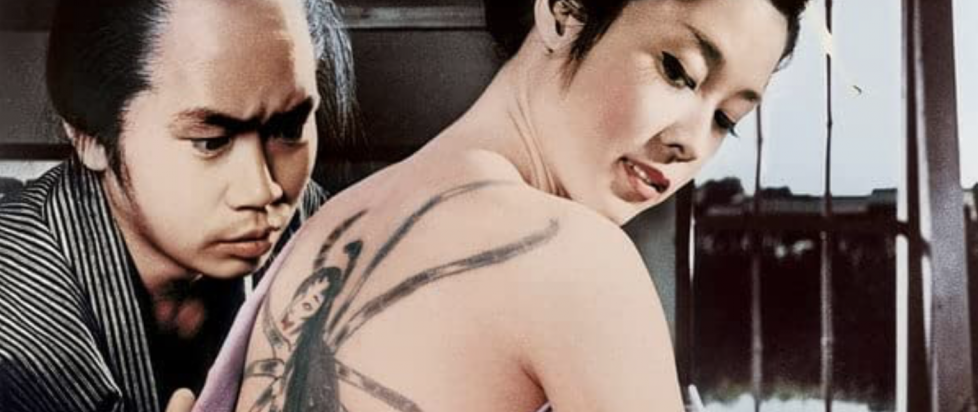
A Born Man-Eater: Irezumi (1966) on Blu-ray
“It no longer pays to be honest.”
Not that long ago, I wrote about Giants and Toys (1958), another film from celebrated director Yasuzo Masumura released on Blu-ray by Arrow Video. At the time, I said that Blind Beast (1969) was the only other film of his that I had ever seen. Since then, Arrow has released another of his classics (and Blind Beast is on the way before long), so I can now add Irezumi to that list.
While I had only ever seen Blind Beast – and it fairly recently – I was at least aware of Irezumi, which is often considered one of the director’s best works, at least here in the West. Released almost midway between Giants and Toys and Blind Beast, Irezumi feels much more of a piece with the latter than the former, partaking, as it does, of similar “ero guro” elements that border on the horror film.
Indeed, as I was watching, reading, and thinking about Irezumi, one of the questions that I kept returning to was just what genre it is, precisely. Sharing cinematic DNA with everything from rape revenge films to “women’s pictures” to the ero guro movement I already mentioned, it is a difficult insect (or arachnid?) to pin down. And while I hesitate to draw broad conclusions about a director’s oeuvre from just three movies, I do feel like “hard to pin down” probably describes a lot of what makes us still watch, write, talk, and think about Masumura’s films today.
Giants and Toys may have been an Audrey Hepburn-esque screwball comedy, but it was also an acidic satire of corporate politics. Blind Beast may be a grotesque about a sculptor who kidnaps a woman and holds her hostage in his unsettling studio, but it definitely doesn’t go where other horror movies with similar loglines might. So with Irezumi, deciding just where to pigeonhole the film becomes almost impossible.
As with Blind Beast, Masumura was working from the writings of one of Japan’s most celebrated literary figures at the time. In that case it was Edogawa Rampo, in this case it’s Jun’ichiro Tanizaki. In fact, Irezumi marks the second (of three) times that Masumura would adapt Tanizaki’s works to the screen, and much of the booklet that accompanies the Arrow Video Blu is given over to Tanizaki, Masumura’s relationship with his work, and so on.
In Irezumi, the source material is a short story, one of Tanizaki’s earliest, “The Tattooer.” While the story was apparently originally set in the then-contemporary Japan of the 1910s, when its publication caused a scandal, Tanizaki moved the setting to the Edo period, which is where the film takes place. As its title might suggest, the short story focuses on a tattoo artist who delights in the pain that he causes. When he encounters a particular woman, he becomes obsessed with inking his masterpiece onto her skin. He tattoos her back with an image of a great black spider, and the story ends as she turns to him and says, “You are my first victim.”
All of that is certainly in Irezumi, but the screenplay by Kaneto Shindo (the writer/director of Onibaba) adds so much more. Here, the focus of the story is on Otsuya (Ayako Wakao), Tanizaki’s “self-aware woman” and, according to Arrow, Masumura’s muse. After pressuring her lover to elope, she finds herself kidnapped and sold into prostitution, marked by the tattooist with the film’s symbol, the spider with a woman’s face that seems to creep across her back.
“See how fascinating this portrait is?” her new owner asks, showing her a painting while explaining what he expects her to become. “A beauty trampling the corpses of countless men at her feet, feasting on their flesh and blood to grow and prosper.”
He expects Otsuya to make him rich. That tattooist seems to expect her to be his living canvas. Her fiancé expects her to still be the woman he ran away with. In all their cases, she becomes something much more, at once outpacing all their expectations while simultaneously becoming the thing that she always was, something at once monstrous and yet self-actualized in a way that makes her monstrousness seem more transcendent than tragic.
Even as the spider mark is the end of the original story, it is the beginning here. The beginning of a trail of vengeance and bloodshed, as Otsuya and her lover slay one person after another, first out of self-defense, eventually out of vengeance or a hatred even more primal, until Shinsuke, Otsuya’s unfortunate fiancé, laments that, “Killing people has become a mindless pattern.”
One of the things that makes Irezumi work as brilliantly as it does is the way these moments of violence are handled. Virtually everything else in the film is sensual and beautiful, from the music to the mise en scene to the shots of the tattoo crawling across Otsuya’s skin. The violence, however, is as far from sensual as possible. It is strenuous, ugly, difficult, and messy. There are no beautiful samurai duels in bamboo groves here. There is only blood and mud and struggle.
There’s a line in the (much worse) Feardotcom, from 2002, when Stephen Rea’s murderous physician says, “I believe death should be repulsive, so we don’t grow too fond of it.” The death in Irezumi is repulsive indeed, even as the wages of growing too fond of it are vividly portrayed.





